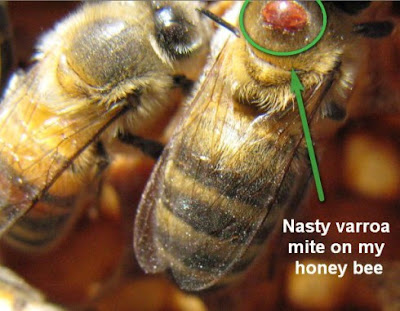First, a standard bottom board (non-screened) is little more than a piece of sturdy wood with edges around three of the four sides. It is the bottom-most part of the hive. These edges hold up the rest of the hive, and they also allow a space for the bees to crawl across at the bottom of the hive after they enter. I don't have a picture of my own bottom boards, but here is a good image of one. The picture is attributed to this address.
 |
| A hive's bottom board. |
Above, painted white is a bottom board. The raised edges that you can see along the back and on the left and right edges hold up the hive bodies that are above it. The gap in the front, where the bottom board lacks an edge or ridge, will make a wide hole through which bees enter and exit the hive. The wood "stick" that you can see is the entrance reducer. That is used to make the opening smaller during certain seasons or when the hive population is too low to need or be able to defend the larger opening.
Almost all honeybees have to contend with the Varroa destructor mite. The image below is attributed to this address.
 |
| A tick is to a human as a mite is to a honeybee. |
The following picture is not one of mine. Its attribution is here. But, it shows nicely how the mite attaches to a bee.
 |
| The mite is attached to a honeybee's thorax. |
In daily living and grooming, these mites will occasionally fall off the bees. If you are using a standard bottom board, the mites will land on that. They don't die from the fall. They will crawl around on the surface of the bottom board until a bee goes past them that they can grab onto in order to parasitize.
If, however, you use a screened bottom board (picture attributed to this site)...
 |
| A screened bottom board. |
...a portion of the mites will fall through the screen. It will be hard for them to travel the distance needed to get back to the area of the bees and re-attach to one of them.
Moreover, if you have a layer of plastic underneath the screen and it is covered with something sticky or oily, the mites will be trapped. This will help in two ways: (1) The mites cannot get back onto a bee to suck their hemolymph and eventually reproduce, and (2) The mites can be counted to monitor the infestation level of the hive.
In this video, I install a sticky board under each screened bottom board under each hive. Hive A gets one with an insert under the screen that is covered with Vaseline only along the periphery. Hive B gets one with an insert that is fully covered with Vaseline.
No comments:
Post a Comment